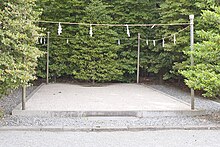User:Tenmei/Sandbox-R
| This is a Wikipedia user page. This is not a Wikipedia article or the talk page for a Wikipedia article. If you find this page on any website other than Wikipedia, you are looking at a mirror site. This page may not be up to date, and the user who made this page may have no relationship with any site other than Wikipedia. The original page can be found at https://simple.wikipedia.org/wiki/User:Tenmei/Sandbox-R. |
This page has been removed from search engines' indexes.

Ryukyu territorial question
changeCounterargument table
changeAn illustrative table is construed as "overall bad editing" at Talk:Counterargument#Coatracking.
The value, utility and necessity of the table are each demonstrated by the terse diff which accompanied the blanket deletion of the illustrative counterexample table -- QED. As you know, for a given argument, there is often a large number of counterarguments, some of which are not compatible with each other. If this table is incompatible with our project goals, this thread will help clarify the point:
- Illustrative table
- The table below presents counterexamples as a type of counterargument. The cells of the table are rebuttals to foreign policy position of the People's Republic of China.[1] In the context of a disagreement about the sovereignty of a small group of islands in the East China Sea, the examples in the table are contradictions of a 2010 statement by Chinese Foreign Ministry spokeswoman Jiang Yu, who told reporters: :"The Diaoyu Islands [the Chinese name for these disputed islands] have always been Chinese territory since ancient times, and this is the fact that nobody can ever change. China owns indisputable sovereignty over the Diaoyu Islands. The Chinese government’s will and determination to safeguard national sovereignty and territorial integrity is firm and unshakable."[2]
- The examples in the table are insufficient to resolve the full array of underlying issues which are implicit in the spokeswoman's comments.[3] That is conceptually different,[4] because the scope of rebuttal is limited by the thesis or statement to which the counter-argument is a response.
Support Statement Type Support Statement Type Support Statement Type Description of "the Senkaku Islands, Yaeyama District, Okinawa Prefecture, Empire of Japan" in the letter of appreciation dated May 1920 sent from the then consul of the Republic of China in Nagasaki concerning the distress which involved Chinese fishermen from Fujian Province around the Senkaku Islands.[6] Letter Partial image of newspaper article: "Struggle of the people of the Ryukyu Islands against U.S. occupation" (琉球群岛人民反对美国占领的斗争), People's Daily (人民日報), January 8, 1953.[6]
*NOTE: In second character cluster of the second line of the published text, see Japanese kanji characters identifying Senkaku Islands (尖 閣 諸 島, Senkaku Shotō)[7]Article World Atlas published in China in 1960[6] *NOTE: At A, see Japanese kanji characters identifying the Senkaku Islands (尖 閣 諸 島, Senkaku Shotō); and at B, see maritime boundary between Taiwan and Japan Map
Response 1 Response 2 Response 3 Rebuttal and refutation of Chinese irredentist statement, see MOFA at Q&A, Senkaku Islands, Q4/A4.3[6] Rebuttal and refutation, see MOFA at Q&A, Senkaku Islands, Q4/A4.3[6]
Rebuttal and refutation, see MOFA at Q&A, Senkaku Islands, Q4/A4.3[6]
This small article has enhanced significance in our collaborative editing project. The term is highlighted at WP:Dispute resolution in the graphic pyramid developed from
Miscellaneous
change- Endorse edit summary and neologism-phrase "structured subpage":
- div 23:07, 31 August 2010 Tony Sidaway (47,074 bytes) (→Climate change: Careful consideration of case page structure may pay dividends.)
- This analytical perspective attracted my interest. I'm also attracted to the term "dividends" because it implies "investment" in a context of dispute resolution. --Tenmei (talk) 00:16, 1 September 2010 (UTC)
Notes
change- ↑ The positions of the parties in a dispute are noteworthy, but they must be clearly marked as such -- in this instance, the position of the Chinese, and a rebuttal using Chinese-published counterexamples.
- ↑ Gertz, Bill. "Inside the Ring: China-Japan Tensions," Washington Times (US). September 15, 2010.
- ↑ Compare venire contra factum proprium (No one may set himself in contradiction to his own previous conduct); and MOFA, Q&A, Senkaku Islands, Q4
- ↑ MOFA, The Basic View on the Sovereignty over the Senkaku Islands
- ↑ MOFA, Q&A, Senkaku Islands, Q4
- ↑ 6.0 6.1 6.2 6.3 6.4 6.5 MOFA at Q&A, Senkaku Islands, Q4/A4.3
- ↑ See 4th page of the digitially archived copy of the People's Daily, 8 January 1953